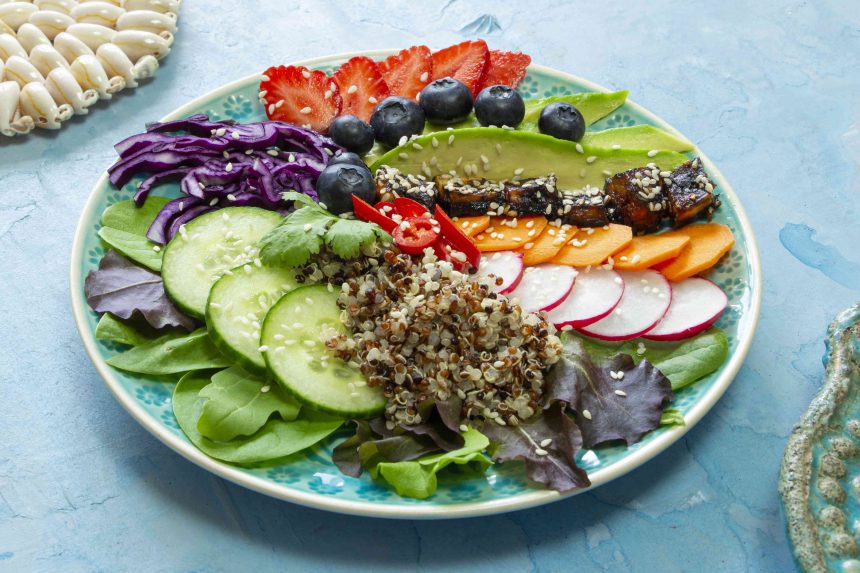Though often overlooked, lunch is a crucial meal. “Lunch isn’t just a midday pit stop; it’s your fuel station for the second half of the day,” says Sapna Peruvemba, MS, RDN. But in the midst of a busy day, the last thing many of us have time for is conjuring up a healthy lunch that is quick, convenient, and (maybe most importantly) delicious.
- Sapna Peruvemba, MS, RDN, registered dietitian and founder of Health by Sapna
We’re here to help with a list of 10 of the healthiest lunch options that you can always keep in your back pocket. These foods contain essential nutrients that easily fit into a range of balanced meals to give you the boost you need to tackle the rest of your day.
10 of the Healthiest Foods for Lunch
While the healthy lunch food options are nearly endless, here are 10 of our most accessible favorites to reach for on a regular basis. “These foods provide a solid mix of protein, fiber, and nutrients, giving you that much-needed energy boost without the post-lunch slump,” Peruvemba adds.
Leafy Greens
Whether it’s spinach, kale, arugula, or hearty lettuces, leafy greens are an excellent mid-day food choice. “They’re packed with antioxidants and vitamins,” says Peruvemba. Leafy greens are also loaded with water and often fiber, both of which can keep you satisfied until dinner. Plus, whether you love a hot or cold lunch, leafy greens can fit into most any savory lunch recipe. Pastas, loaded salads, soups, or roasted vegetable medleys, like this Roasted Acorn Squash Salad, are all delicious ways to add leafy greens to your lunchtime meal.
Quinoa
Whole grains of all kinds, including whole wheat bread, brown rice, and whole wheat pasta, are often cornerstone foods of a balanced lunch. “This is because they are great sources of complex carbohydrates,” Peruvemba explains. Quinoa may take the cake as one of the healthiest whole grains (though it’s technically a seed, as all whole grains are seeds!) as it not only contains a robust amount of fiber and micronutrients, but it also is rich in protein, with eight grams of complete protein per one cup cooked. With that amount of protein, it’s sure to leave you feeling appropriately full after lunch. This South American staple can be easily integrated into stir fries, soups, stews, salads, or loaded bowls like this Mole-Spiced Black Bean and Quinoa Bowl.
Cucumbers
Any and every veggie that you love fits in a healthy lunch, but cucumbers are one of the most popular mid-day veggies (though botanically a fruit) thanks to its satisfying crunch and mild flavor, lending it to a range of dishes. Plus, the water and fiber it contains promotes a feeling of fullness. Cucumbers can be integrated into several lunch recipes, including a simple crudités platter, a Mediterranean-inspired grain bowl, or salads such as this Lemony Pasta Salad with Cucumber.
Canned Chickpeas
Chickpeas are one of the most versatile legumes, as they can be added to a variety of lunch recipes like stews, soups, hummus, or salads, such as this Chickpea-Tuna Salad. Other legumes like lentils, pinto beans, black beans, kidney beans, and edamame all fit this lunch bill as well. “This is thanks to the fact that they’re great sources of fiber, complex carbohydrates, and minerals,” Peruvemba adds. All of these options are also rich plant-based protein sources, increasing their staying power even more.
Apples
As a classic lunchbox addition, apples are an equally fantastic adult lunch choice. They are a hearty source of fiber, plant compounds, vitamins, and minerals, and they will be sure to leave you feeling nourished and energized for the rest of your day. Plus, these beloved fruits can be included in both sweet and savory lunch recipes. Tasty options include salads, sandwiches, leftover tray bakes, smoothies (like this Kale Apple Smoothie recipe), dip for peanut butter, or enjoyed just as is.
Walnuts
“Nuts like almonds, walnuts, peanuts, and cashews are high in healthy fats and plant protein, ideal for lunch,” says Peruvemba. And while any nut you love is a fantastic lunch addition, walnuts are a particularly excellent one, as they are one of the few plant-based sources of anti-inflammatory omega-3 fatty acids, which support both heart and immune health. While homemade trail mix, salads, walnut butter sandwiches, or fruit dips are all tasty ways to integrate this nutritious nut into lunch, reheating scrumptious leftovers like this Walnut Mushroom Bolognese recipe also hits the spot.
Nitrate-Free Turkey
Few things are as satisfying as a loaded sandwich at lunchtime. And while processed meats, including deli meat, are classified as Group 1 carcinogenic foods per the World Health Organization (WHO), it doesn’t mean a hearty sandwich is off the table for lunch. Whether you roast chicken or turkey at home and slice it, or opt for nitrate-free deli options, there are still plenty of ways to enjoy a protein-rich turkey sandwich, like this Chipotle Turkey Club. “Protein is your satiety hero,” Peruvemba reminds us. Plus, the more veggies you add to your sandwich, the more satisfied you’ll feel!
Avocado
Speaking of sandwiches, avocado is a top-tier sandwich addition, as it is an excellent source of satiating healthy fat, fiber, and micronutrients. But your avocado lunch options are not only limited to sandwiches. You can add avocado to salads, taco bowls, and stews, or blend it into a nutritious dip like guacamole or this Charred Poblano, Avocado, and Pepita Dip for dunking your favorite whole grain crackers or veggies into.
Eggs
Though often typecast as a breakfast food, eggs are equally delicious at lunch. Plus, their protein and fat content offer the surge of energy needed to get through that dreaded midday slump. Whether you enjoy them hardboiled, added to salads (like this amazing Niçoise-Inspired Potato Salad), or made into egg salad for sandwiches, it’s hard to go wrong with eggs for lunch.
Greek Yogurt
And finally we have Greek yogurt, “a great source of probiotics and protein,” says Peruvemba. Probiotics help to support gut health, while protein will keep you feeling full until at least happy hour. While fruit, Greek yogurt, and granola is an easy lunch go-to, Greek yogurt can also be added to smoothies, dressings, and even soups, like this sophisticated Green Gazpacho with Smoked Trout option.
Healthiest Lunch Nutrients
If you haven’t already guessed, there are a handful of nutrients that you ideally want to include in a lunch that’s aimed at fullness and satisfaction.
Generally, these include the three major macronutrients—lean protein, healthy fat, and complex carbohydrates—plus a range of micronutrients. The three major macros all slow digestion, helping to regulate blood sugar levels and maintain stable energy levels after eating. Meanwhile, micronutrients (whether they come from plant compounds, vitamins, or minerals) can support brain, immune, and total body health, depending on the specific type. “Additionally, hydration is key! Dehydration can contribute to fatigue and reduced concentration, so alongside your nutritious lunch, remember to drink water throughout the day to help keep your mind sharp and your energy steady,” says Peruvemba.
Generally, protein can be found in legumes, nuts, seeds, dairy, eggs, poultry, and lean meats, whereas complex carbs are prevalent in whole grains, fruits, and veggies. Healthy fats are often found in nuts, seeds, avocado, olives, and fatty fish, while micronutrients are usually most concentrated in plant-based options like fruits, veggies, nuts, seeds, and legumes. However, certain vitamins and minerals are found in animal-based foods like seafood, lean meats, eggs, dairy, and poultry.
“Together, these nutrients create a meal that supports sustained energy, mood balance, and mental focus. Skimping on any of them can leave you reaching for snacks later, or struggling to concentrate,” Peruvemba explains.
Foods to Avoid for Lunch
On the other side of the coin, there are a few nutrients and foods we want to steer clear of at lunchtime, assuming we want to have a productive second half of the day. These include added sugars, refined carbohydrates, and super fatty foods. You’d find these in sweets, desserts, and sugar-sweetened beverages; white bread and grain products; and options like processed meats, fatty cuts of meat, burgers, fries, burritos, and any fried foods, respectively.
“Quick-burning carbs like added sugars and refined carbs tend to cause a rapid blood sugar spike, followed by an energy crash, which can leave you feeling hungrier and craving more sweets soon after,” Peruvemba explains. Additionally, fatty foods can leave you feeling sluggish and low-energy after lunch.
Is Lunch Important?
So, while you may be able to answer this question for yourself at this point, let’s delve a little deeper into why lunch is so important.
“While that infamous ‘afternoon slump’ often ties into our natural circadian rhythm, diet can either cushion or intensify it. What you eat—or don’t eat—can make all the difference in how energized or groggy you feel,” Peruvemba explains.
But aside from energy levels, lunch is critical for helping our brain perform at its peak. “Food is more than fuel; it’s also essential for mood and focus. Our brains run on carbohydrates, so skipping meals like breakfast or lunch can leave you foggy and distracted. That’s why a balanced lunch isn’t just about filling up, but also about powering your productivity and well-being through the rest of your day,” Peruvemba concludes.






